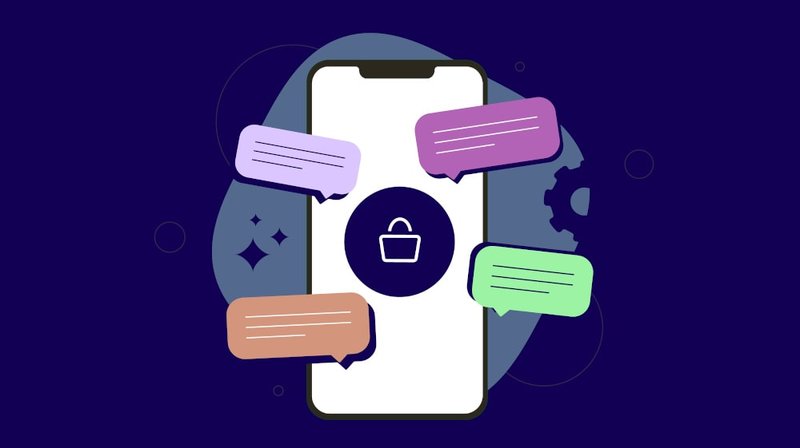What Is Conversational Commerce? How Chat and Messaging Are Changing Online Shopping
- Home
- Knowledge Sharing
- What Is Conversational Commerce? How Chat and Messaging Are Changing Online Shopping
Key Takeaways
- Conversational commerce blends messaging and shopping into seamless, real-time experiences.
- AI, especially natural language processing (NLP) and machine learning (ML), is at the heart of this shift.
- Tools like chatbots, SMS, and voice assistants enable 24/7 personalized service, which increases conversions.
- Online retailers are using this model to reduce cart abandonment and improve customer engagement.
- Expert insight from industry leaders highlights the strategic importance of this trend.
What exactly is conversational commerce, and why does it matter today?
Imagine messaging your favourite clothing store on WhatsApp, asking for new arrivals in your size, and completing the entire purchase without leaving the chat. That’s the power of conversational commerce — the integration of messaging, voice, and AI-powered interactions into the buying process.
Defining Conversational Commerce
Coined by Chris Messina in 2015, the term "conversational commerce" refers to the intersection of messaging apps and shopping experiences. It encompasses platforms like:
- SMS marketing and support
- Chatbots are integrated into websites or apps.
- Messaging apps like WhatsApp, Facebook Messenger, or Instagram DMs
- Voice assistants such as Alexa, Google Assistant, and Siri
These tools help businesses connect with customers in real-time and offer personalized experiences — without forcing them to navigate clunky websites or apps.
How Conversational Commerce Has Evolved
Initially used by early adopters through live chat widgets, conversational commerce has expanded with the rise of mobile-first consumers and the advancement of AI capabilities . Now, it's essential for omni-channel strategies and consumer touchpoints, from pre-sale questions to post-purchase support.
According to Statista, messaging app usage worldwide surpassed 3 billion users in 2021 — and continues to climb. This shift underlines why conversational commerce isn't just a trend — it's a necessity.
Why It Matters Today
Modern consumers expect immediacy, personalization, and convenience. They want:
- Instant answers to questions
- Quick order processing
- Real-time recommendations
And businesses that deliver on this? They’re seeing measurable results. According to the study "Conversational Commerce: The Next Era of Retail" by IBM, 70% of businesses reported increased customer satisfaction and loyalty after implementing conversational tools.
"Conversational commerce is more than just chatbots. It's about building meaningful, frictionless customer journeys," says Alyona, Senior SEO Strategist at Seologist .
From small Canadian boutiques to global ecommerce giants, conversational commerce is quickly becoming the default method of engaging customers.
How is AI driving the rise of conversational commerce?
You’ve likely interacted with an AI-powered chatbot without even realizing it. And that's the point — it feels natural, seamless, human. AI is the secret engine powering conversational commerce, making it smarter, faster, and more impactful.
AI-Powered Chatbots and NLP
Artificial Intelligence allows businesses to deploy chatbots capable of handling:
- Product queries
- FAQs
- Personalized suggestions
- Order updates and shipping info
Natural Language Processing (NLP), a subset of AI, enables these bots to understand and respond to human language. That means your customers don’t need to use exact phrases or commands — they can talk normally, and still get what they need.
Machine Learning and Real-Time Personalization
The more interactions these AI systems have, the more intelligent they become. Through machine learning (ML), bots learn from each customer’s behaviour:
- Past purchases
- Browsing history
- Abandoned cart behaviour
- Time of day or device used
This data fuels real-time personalization, delivering tailored product recommendations and content at the moment it’s most likely to convert.
Examples from E-commerce Brands
Let’s look at some real-world applications:
- Sephora utilizes Messenger bots to provide skincare quizzes and schedule in-store appointments.
- Loblaws offers SMS updates and lets customers manage grocery pickups through automated systems.
- Indigo integrates live chat to provide personalized book suggestions.
These brands aren't just saving customer support time — they’re building trust and increasing repeat purchases.
“AI enables a smarter, more efficient e-commerce experience where the customer doesn’t have to work hard to buy. That’s the new standard,” says Mike Zhmudikov, SEO Director at Seologist .
| Feature | Traditional E-commerce | Conversational Commerce |
|---|---|---|
| Customer support | Email or help desk | Chatbots, messaging, live chat |
| Personalization | Basic product filters | AI-driven, behaviour-based |
| Speed of response | Hours or days | Instant |
| Platform | Website or app | Messaging apps, SMS, voice |
| Conversion funnel | Multi-step | Embedded in conversation |
AI streamlines the shopping process, making it shorter, more relevant, and less intrusive — just the way modern consumers prefer.

What are the top benefits of conversational commerce for online retailers?
What happens when your online store can chat, suggest solutions, and resolve problems 24/7? Conversion rates increase, customers stay longer, and abandoned carts decrease.
Increased Conversions
Conversational interfaces reduce friction. A Shopify study found that businesses using chat tools experienced a 3.5 times increase in conversion rates. Why?
- Questions are answered instantly.
- Products are matched to needs in real-time.
- Transactions happen within chat, minimizing drop-offs.
24/7 Availability
Your customers don’t shop only during business hours. With AI chatbots or messaging automations, businesses can:
- Provide service across time zones
- Handle hundreds of queries simultaneously.
- Resolve issues faster than human agents.
That availability translates to higher customer satisfaction scores.
Improved Engagement
Personalized conversations boost engagement. Instead of generic email blasts, messaging apps allow:
- One-on-one product suggestions
- Targeted promotions
- Cart reminders with personalized hooks
This level of engagement encourages repeat visits and loyalty.
Lower Cart Abandonment
One of the most significant issues in e-commerce is customers dropping off before completing their purchase. Conversational tools combat this with:
- Real-time nudges
- Discounts offered automatically by chatbots
- Payment assistance or clarification on shipping costs
A Baymard Institute report shows that the average cart abandonment rate is 69.8%, and conversational commerce tools can reduce that by up to 30%.
| Benefit | How It Helps Retailers |
|---|---|
| Higher Conversions | Real-time, frictionless purchases |
| Always-On Service | Serve customers anytime, anywhere |
| Stronger Engagement | Personalized, two-way conversations |
| Fewer Abandoned Carts | Automated reminders and support |
| Data-Driven Insights | Learn what customers want in real time |
By implementing conversational commerce, online retailers position themselves to meet modern expectations and unlock new levels of customer satisfaction.
How are customers interacting with brands through chat and messaging?
When was the last time you emailed a brand? Now compare that to the last time you used Instagram DMs or Facebook Messenger to ask a product question. Exactly. The shift is massive.
Messaging Channels in Use
Today’s consumers are engaging brands directly through:
- WhatsApp: Especially popular among international brands and for providing real-time support.
- Facebook Messenger: Integrated with e-commerce for catalogue browsing, payments, and support.
- Instagram DMs: Used heavily for visual product queries, influencer engagement, and branded conversations.
Even in Canada, local retailers have adopted these platforms for customer service and promotions. Why? Because this is where consumers already are.
Customer Expectations
Consumers want conversations — not transactions . They expect:
- Instant responses (within minutes, not hours)
- Human-like tone, even from bots
- No “formality” — just ease and access
A Topical Research study shows that 83% of customers feel more loyal to brands that respond via chat. Reviews from forums like Reddit and Trustpilot reveal that fast, friendly interactions often outperform even high-quality products in satisfaction rankings.
User Comfort with Chat-Based Shopping
Younger audiences, particularly Gen Z and Millennials, have become accustomed to chatting with brands. In forums like ProductHunt and StackSocial, shoppers share:
- Positive experiences buying through DMs
- Frustration when brands don’t reply
- A preference for chat-first discovery and support
As one Redditor shared: “If I can’t message a brand directly, I don’t trust them. I want to know someone’s on the other side.”
And they’re not alone. Messaging is convenient, mobile-first, and flexible — a perfect fit for the modern lifestyle.
What are the key conversational commerce trends to watch in 2026?
Trends aren’t guesses — they’re early signals . The next wave of conversational commerce may seem futuristic, but it’s already underway.
Voice Commerce
Thanks to Alexa, Siri, and Google Assistant, voice-enabled shopping is expanding. By 2026, expect:
- More retail sites are integrating voice commands
- Personalized reminders through voice assistants
- Seamless ordering via smart home devices
Live Shopping via Chat
Already trending in China, live video + messaging = the future of e-commerce . Shoppers will:
- Watch product demos in real-time
- Ask questions in chat.
- Buy instantly without leaving the stream.
Instagram Live and TikTok Shop are leading the way in this regard.
Hyper-Personalized Chatbots
Expect bots to move from scripted flows to predictive intelligence. Features include:
- Knowing customer intent before a query is typed
- Recommending bundles based on mood or context
- Using sentiment analysis to shape tone
Multilingual and Localized AI
With global commerce booming, chatbots will support:
- Auto-translation in real time
- Local idioms, slang, and tone
- Cross-border compliance is built into interactions.
AR Integration in Messaging
One tap from chat, and you’re virtually trying on glasses or seeing a sofa in your room? AR inside messaging apps will unlock this:
- Virtual try-ons
- Spatial shopping experiences
- Visual product walkthroughs
| Trend | 2023 (Current State) | 2026 (Future Outlook) |
|---|---|---|
| Chatbots | Scripted responses | Predictive, personalized, multilingual |
| Messaging platforms | Text-based engagement | Voice, AR, and live video embedded |
| Personalization | Basic AI-based suggestions | Hyper-contextual and sentiment-aware |
| Languages Supported | English-heavy | Global, localized, dialect-aware |
| AR Use in Commerce | Separate apps | Embedded directly in chat/messaging |
The shift is clear: more immersive, more human, and more intelligent experiences are on the way.

How does conversational commerce differ across e-commerce and retail sectors?
Not all retail is built the same — and neither is conversational commerce. Let’s explore how different sectors are adapting.
D2C Ecommerce: Full-Funnel Integration
Brands that sell directly to consumers online are using chat for:
- Product discovery (quizzes, bots)
- Purchase (embedded checkout)
- Post-sale support (returns, order tracking)
Physical Retail with Online Presence
Brick-and-mortar brands with online arms focus on:
- Appointment booking via Messenger or DMs
- Curbside pickup and inventory questions
- Loyalty programs managed via WhatsApp
| Sector | Use of Conversational Commerce |
|---|---|
| D2C E-commerce | End-to-end sales funnel in chat |
| Brick-and-Mortar Retail | Customer service, pickup, loyalty, and in-store traffic boosts |
| Hybrid Retailers | Unified messaging to bridge offline and online experiences |
How do brands implement conversational commerce successfully?
Launching a conversational commerce strategy isn’t about adding a chatbot to your homepage and hoping for the best. It takes a structured approach, tech-savvy execution, and ongoing measurement.
Step 1: Planning the Strategy
Begin by defining clear goals:
- Are you looking to increase sales?
- Improve customer service response times?
- Lower support costs?
Next, identify your audience:
- Where do they interact (WhatsApp, Messenger, etc.)?
- What are their common questions or pain points?
Customer journey mapping helps prioritize touchpoints where conversations will have the most impact.
Step 2: Choosing the Right Tools
The platform should match your use case. Options include:
- Live chat tools (e.g., Zendesk , LiveChat )
- Chatbot builders (e.g., ManyChat , Tidio )
- AI-powered platforms (e.g., IBM Watson Assistant , Ada )
Also, ensure compatibility with channels your customers already use, such as:
- Instagram DMs
- Facebook Messenger
- WhatsApp Business
- Google Business Messages
Step 3: Training the AI
If using AI, invest time into:
- Conversation flows and intent mapping
- Feeding it real queries from customer support logs
- Testing edge cases (sarcasm, typos, slang)
Use data from actual chats to improve NLP accuracy and user experience.
Step 4: Integrating with CRM and E-commerce Stack
To make it more than a novelty, integrate your conversational tools with:
- CRM platforms like Salesforce , HubSpot , or Zoho
- E-commerce platforms (e.g., Shopify , WooCommerce )
- Email marketing tools and analytics
This allows personalized recommendations, contextual support, and comprehensive reporting.
Step 5: Measuring ROI
Set KPIs and use analytics dashboards to track:
- Conversion rates from chatbot flows
- Average response time
- Chat-to-sale ratios
- Customer satisfaction scores (CSAT or NPS)
Tip from ecommerce consultants at Bold Commerce: “Treat your conversational commerce flows like your email marketing funnels — track open, click-through, and drop-off points.”
Begin with a limited scope, such as handling FAQs or order status, and then expand to full-funnel commerce once performance proves itself.

Are there any risks or downsides to adopting conversational commerce?
As with any tech-driven strategy, conversational commerce comes with potential pitfalls. Ignoring these can damage trust, conversion, and even brand reputation.
Risk 1: Privacy and Data Concerns
Chat interfaces often collect sensitive user information:
- Contact details
- Purchase history
- Payment data
Failure to comply with privacy laws (like PIPEDA in Canada or GDPR in the EU) can result in fines.
Mitigation Tip : Work with compliance experts and clearly disclose data usage. Ensure end-to-end encryption and follow secure storage protocols.
According to legal advisors at Osler, “Brands must implement chatbot audit trails, privacy disclaimers, and user consent protocols as part of ethical deployment.”
Risk 2: Chatbot Errors or Inaccuracies
Bots that give incorrect answers or misinterpret tone can frustrate users.
Mitigation Tip : Use human handoff options for complex queries, and regularly retrain AI models using customer feedback.
Risk 3: Over-Automation and Lack of Personal Touch
Too much automation risks alienating customers. If every interaction feels scripted or robotic, users may disengage.
Mitigation Tip : Design chatbot personas with a brand tone and sense of humour. Include options like "Talk to a human" for added empathy.
Risk 4: Tech Stack Incompatibility
If your chatbot can’t talk to your CRM, ecommerce system, or support tools — it’s just a glorified FAQ.
Mitigation Tip : Ensure integrations are prioritized from the start. Many tools offer plug-ins or APIs to facilitate seamless integration between systems.
Despite these risks, the benefits can far outweigh the downsides — if implemented thoughtfully.
What does the shift to conversational commerce mean for SEO and digital marketing?
Conversational commerce isn’t just changing how people buy — it’s changing how they search, how brands optimize content, and how visibility is measured.
Shift in Search Behaviour
Voice assistants and AI chatbots are prompting users to search conversationally:
- “What’s the best wireless speaker under $200?”
- “Where can I buy eco-friendly shampoo near me?”
Long-tail, question-based queries are becoming the norm.
SEO Implication : Brands must create content that naturally and succinctly answers these questions. Think FAQ schemas, how-to guides, and featured snippets.
Rise of Voice Search
By 2026, voice search is projected to account for over 50% of all queries (according to Comscore research).
Implication for marketers :
- Optimize for local search: “near me” is common in voice queries
- Use structured data to help search engines interpret your content
- Write content in natural, conversational tones
Structured Data and Conversational Content
Chatbots and voice assistants are changing content discoverability:
- Google is indexing chatbot-based interactions
- Structured data like FAQPage, Speakable, and HowTo are becoming essential
Utilize schema.org markup to enhance the visibility of your content on conversational search platforms.
Marketing Strategy Evolution
Marketers need to align messaging across:
- Conversational channels (chat, SMS, voice)
- Organic search and content strategies
- Paid channels like click-to-message ads
As the funnel becomes more dynamic, conversation-first touchpoints will dominate upper and mid-funnel marketing.

How do customer expectations evolve with conversational AI tools?
Consumers aren't just passively adapting to conversational commerce — they're driving its evolution. As AI becomes increasingly ingrained in how people shop, expectations regarding speed, tone, accuracy, and transparency are rapidly evolving.
The Psychology Behind Instant Gratification
Chat and messaging tools are built on the backbone of immediacy. In a world of instant everything, consumers have grown conditioned to expect:
- Response times under 2 minutes
- Clear resolution without being transferred
- Thoughtful follow-ups (e.g., reminders, order tracking)
Forum reviews across platforms like Reddit , Trustpilot , and Quora reveal a clear preference for businesses that "reply quickly and help without pushing me to call."
Expectations for Tone and Language
As AI bots replace human agents in many first-touch interactions, tone becomes essential. Customers expect bots to be:
- Friendly but professional
- Human-sounding — not mechanical
- Adaptive in tone (empathetic when resolving issues, upbeat during promotions)
For example, Topical Research on AI-based interactions showed that 72% of consumers will abandon a conversation if it feels too robotic.
Transparency is Non-Negotiable
There is a growing demand for ethical and clear communication. This includes:
- Letting users know they’re speaking with a bot
- Explaining how data will be used
- Offering opt-outs and privacy settings
Consumers want to know:
- Who (or what) they’re speaking to
- Why does the conversation feels targeted
- What data is stored
Companies that ignore these expectations risk alienating privacy-conscious shoppers.
Emotional Expectations Are Shifting
This may be the most significant shift of all: people now want emotional intelligence in AI tools. That means bots that:
- Recognize frustration and escalate
- Offer apologies when needed
- Follow up after service hiccups
This shift is particularly evident among Gen Z and Millennial consumers, who grew up chatting and texting. They want AI tools to match their communication style — casual, responsive, and respectful.
How can businesses prepare for the conversational commerce future?
We’ve explored how conversational commerce is reshaping e-commerce, from AI-powered tools to shifts in consumer psychology. But how should businesses act on this information?
| Benefit | Impact |
|---|---|
| Faster Responses | Meets customer demand for instant gratification |
| Personalization | Increases conversion rates and loyalty |
| Always-On Support | 24/7 customer engagement and global reach |
| Reduced Abandonment | Real-time cart recovery and assistance |
| Richer Customer Insights | Better targeting via conversational data |
| Omni-Channel Integration | Aligns customer journey across web, mobile, and messaging platforms |
| Purpose | Tool Example |
|---|---|
| Chatbot Builder | ManyChat, Tidio |
| AI/NLP Platform | IBM Watson Assistant, Google Dialogflow |
| Messaging App Integration | WhatsApp Business, Messenger API |
| CRM & Ecommerce Integration | Shopify, Salesforce, HubSpot |
| Analytics & Feedback Collection | Dashbot, Google Analytics |
Final Thoughts
Businesses don’t need to predict the future — they need to prepare for it. That means:
- Starting with one use case (e.g., post-sale support)
- Choosing tools that scale
- Prioritizing user experience above automation
With conversational commerce, the line between chat and checkout is blurring. Those who embrace it strategically will shape the future of e-commerce — one conversation at a time.
FAQ
What is conversational commerce?
Conversational commerce refers to the use of messaging apps, chatbots, and voice assistants to facilitate real-time communication between brands and customers during the buying journey.
Why should brands invest in conversational commerce?
It enhances the customer experience by providing instant, personalized interactions, increasing conversions, reducing cart abandonment, and fostering brand loyalty.
How does AI enhance conversational commerce?
AI enables natural language understanding, machine learning, and predictive personalization — allowing bots to deliver more intelligent, context-aware responses and product suggestions.
Is it safe to use chatbots for customer interaction?
Yes, as long as brands follow data protection regulations (like GDPR or PIPEDA), use encryption, and clearly communicate how data is collected and used.
How can a brand measure ROI in conversational commerce?
Key performance indicators include conversion rate, chat-to-sale ratio, average response time, and customer satisfaction scores (CSAT or NPS).
What are the risks of using conversational commerce?
Risks include privacy issues, AI misunderstandings, and over-automation. These can be mitigated through proper compliance, training, and offering human support options.
Is conversational commerce only for e-commerce brands?
Not at all. Brick-and-mortar retailers also use it for in-store appointment bookings, loyalty programs, and real-time inventory queries via messaging apps.
Does conversational commerce affect SEO?
Yes. It changes search behaviour toward voice and long-tail queries, encourages the use of structured data, and introduces new strategies, such as chatbot-indexed content.
How are customer expectations changing with conversational AI?
Customers now expect instant responses, a natural tone, and transparent data usage. They want AI to understand their intent, show empathy, and offer thoughtful follow-ups.


